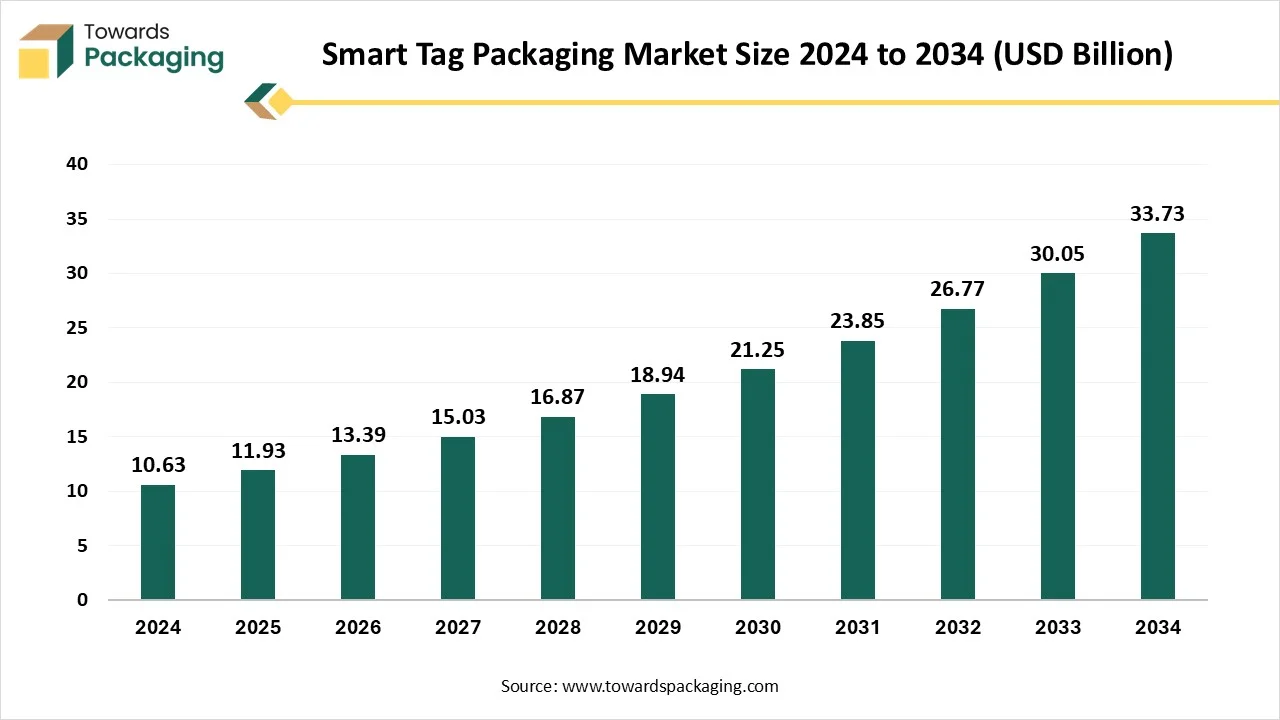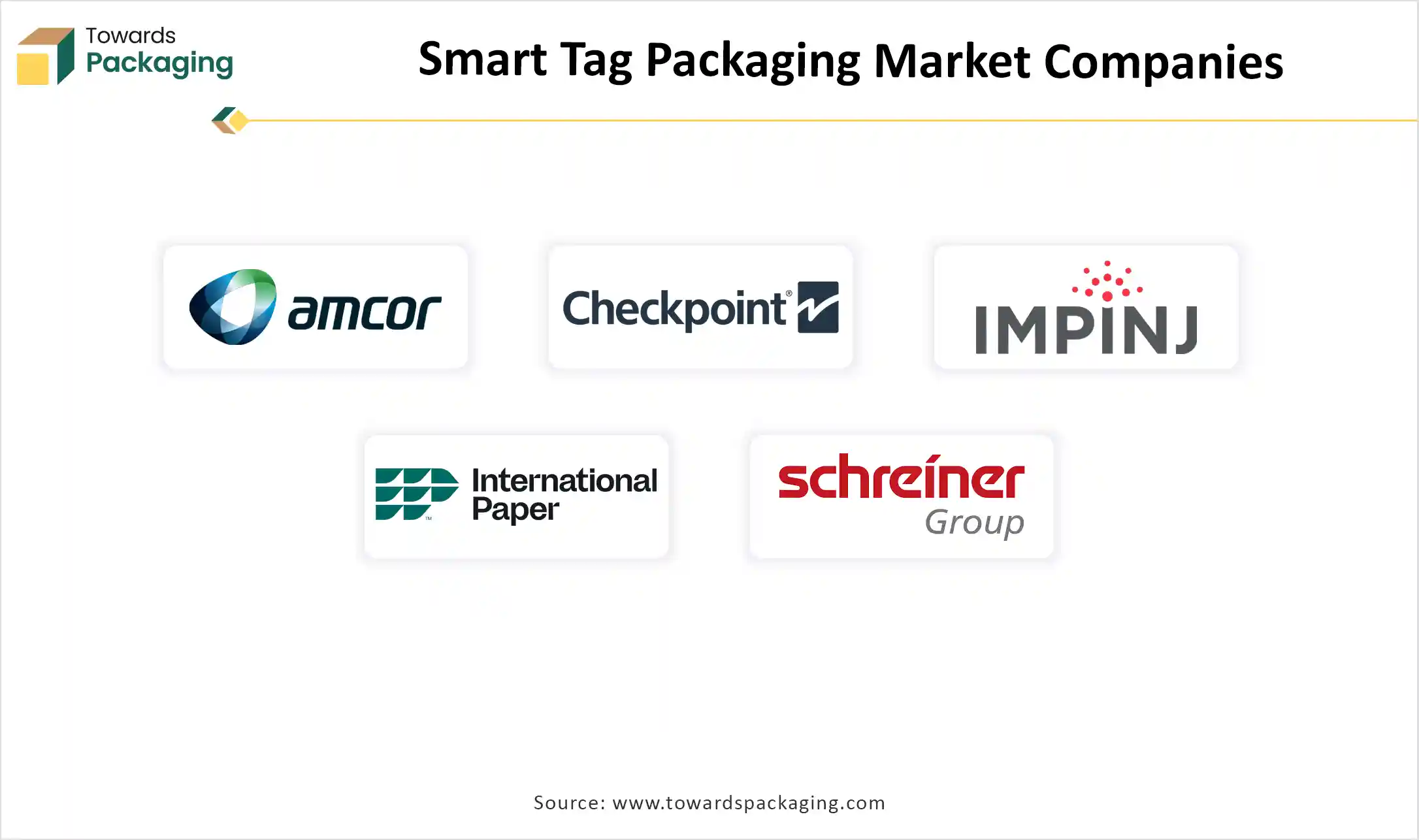November 2025
The smart tag packaging market is expanding rapidly, growing from USD 11.93 billion in 2025 to USD 33.73 billion by 2034, driven by a 12.24% CAGR. This report covers everything from market size and growth trends to material, technology, application, and end-use segments. It provides detailed regional insights across North America, Europe, Asia-Pacific, Latin America, and the Middle East & Africa, showing APAC’s 2024 dominance and North America’s fastest growth. The study also examines leading companies like Amcor, Impinj, Checkpoint Systems, International Paper, and others while offering competitive analysis, value chain structure, global production data, trade flows, and the supplier–manufacturer landscape backed by all relevant statistical information.

Smart tag packaging technology combines the QR code, RFID, and NFC technologies with the traditional packaging solution, which provides real-time tracking of the product, helps automate the operations, enables consumer interaction, and reduces waste while supporting sustainability. The exact product searchability increases with the help of smart tags. In the retail markets, the smart tags have made the operation seamless. Every product containing a smart tag is registered in the computer system, which shows the live sales figures and availability of the inventory positioning. In the healthcare sector, the smart tags are extremely crucial, considering the crucial requirement for accurate monitoring of the pharmaceutical products and medical devices.
Patient data is also managed while maintaining privacy and accuracy. In FMCG, the smart tags are insanely crucial for tracking product authenticity. Which helps deal with product counterfeiting. It is also helped brands to increase customer interactivity. In supply chain management, the smart tags provide real-time tracking of the product and help in seamless operations. The smart tags equipped with thermal and humidity sensors provide real-time data about the product, which helps in taking the right precautions for temperature and humidity-sensitive products during transportation.
| Metric | Details |
| Market Size in 2024 | USD 10.63 Billion |
| Projected Market Size in 2034 | USD 33.73 Billion |
| CAGR (2025 - 2034) | 12.24% |
| Leading Region | North America |
| Market Segmentation | By Material, By Technology, By Application, By End Use and By Region Covered |
| Top Key Players | Amcor, Checkpoint Systems, Impinj, International Paper, Invengo Technology, Multi-Color Corporation |
Integration of AI in the smart tag packaging market has completely changed the efficiency of the packaging industry, AI has enabled automation in the mega warehouses. No manual intervention is necessary; the intelligent systems can interact with the products, read the data automatically, and store it on a computer. By analyzing the crucial product data, AI can provide accurate predictions and crucial insights about the inventory management and supply chain. Based on the data acquired from the smart tag sensors, AI can alert about the freshness of the product to take necessary actions.
This is going to increase the product safety and will help to reduce the waste. AI will be enhancing the overall consumer experience by increasing consumer engagement and brand loyalty. Based on accurate data, the AI can help in making the optimization of effective supply chain routes, production, and inventory-related decisions, which will be based on the current market trends, which products have high demand, and which ones are showing decline. So, the productions can be calibrated accordingly
The Growing E-commerce in All Regions, Need for Visibility and Sustainability Driving the Growth
E-commerce has to deal with millions of orders daily, the QR codes allow the seamless operations. QR codes can be scanned at every checkpoint, providing live data of the shipment to the supplier and the consumer in real-time, which enhances the overall experience. The use of smart tags helps validate the authentic product while tackling the counterfeiting of the original product, which is a highly crucial thing is the case of pharmaceuticals, food items, and personal care products. The ability to reuse the smart tags in sectors like retail and healthcare helps reduce waste while providing accurate data.
High Cost of Materials
Currently, the market is dealing with the high operating cost of the smart tags in the packaging market, the required technological equipment’s and machines are slightly expensive. The advancement is the technology, and an increase in production efficiency of equipment is expected to bring the prices to the lower side. Another significant challenge that is dealt by the smart tag packaging market is the data security and privacy-related concerns. Effective encryption techniques may help in dealing with this concern.
Smart tags containing electronics components are slightly complex to recycle and require very sophisticated procedures and equipment. on a global supply chain, there is a need to establish a universal standard that is not been established yet. Ultimately, flexible government compliance is essential for smooth operations.
Expansion of End-users & Advanced Technologies
Integration of technology in the packaging market is creating a technology-driven ecosystem where the smart tags are playing a very crucial role. In e-commerce, it is simply impossible to perform the millions of daily operations by tracing, tracking, and identifying the product manually. integration of smart tag technology is an inevitable choice. The healthcare and pharmaceutical sector is a sector where the security concerns are very high. To track medical devices, smart tags are going to be essential. The requirement for stopping product counterfeiting in industries like pharmaceuticals, cosmetics, and personal care is going to drive growth for the smart tags market in the near future.
Plastic Dominated the Smart Tag Packaging Market in 2024
Considering its high durability and lightweight, the plastic remains a dominant material in the smart tags packaging market. as the plastic is very versatile and cost-effective for packaging products. It is moisture-resistant; due to this property, it can very easily incorporate various electronic sensors. Polyethylene, polypropylene, and polyester are the most commonly used types of plastic. The fastest growing material in the smart tag packaging market is paper, due to the rising focus on the use of sustainable packaging materials is the packaging stringent government regulations, and the end consumer demand for sustainable packaging solutions is the key driving for in the adoption of paper as a material in smart tag packaging market.
RFID Leading the Technology Segment
RFID (Radio-Frequency-Identification) is dominating the smart tag packaging market due to increased demand for real-time tracking of the products, increasing the inventory management effectiveness, and efficiency of the supply chain. RFIDs are small chips integrated into the packaging that can communicate with the readers wirelessly. NFC (Near Field Communication) technology is expected to show the fastest growth. NFC is an ideal technology for short-distance communications. The NFC technology is primarily used for authenticating the genuineness of the product, as it can be easily scanned by the consumer with a smartphone.
Authentication and Security Held the Largest Market Share
Product authentication is a highly crucial requirement in the current times, particularly in the pharmaceutical sector, which is highly dependent on smart tags in packaging. RFID, NFC, and QR code technology enable the crucial security features that cannot be bypassed by a third party very easily. Parallelly, the anti-theft and loss prevention segment has shown the largest growth due to increasing counterfeiting cases in the pharmaceutical, personal care, and cosmetic industry.
Food and Beverages Segment Dominating the Smart Tag Packaging Market
The huge size of the packaged food market is the main driving factor behind the dominance of smart tag packaging in the food and beverage segment. The food safety and stringent compliance from the government bodies are making it very important for companies to use proper food packaging safety standards. The healthcare and pharmaceutical sector is expected as the fastest growing, considering the high safety requirements in the counterfeiting prevention of medicines and other pharmaceutical ingredients.
The North America region is showing the fastest growth due to the huge packaged food market, the robust penetration of the health care sector. the personal care and cosmetics market is also highly demanding of smart tags due to the rising concerns of product safety and security. This region has very evolved logistic and transport industry where the live tracking of shipments and smooth execution of operations is driven by the use of smart tags solutions. Rising E-commerce is sharing a huge portion of the smart tag packaging market in North America region.
Focus on sustainable solutions in retail sector has shown a notable growth in the European market for smart tags packaging. The demand in the healthcare and pharmaceutical is rising due to the increasing requirement for healthcare support in the European region. The European region is one of the key regions for the personal care and cosmetics brands. Counterfeiting of premium cosmetic products has created a huge threat to the cosmetics brands. Effective utilization of smart tags technology is helping to resolve this issue in the cosmetics industry in the European region.
The Asia-Pacific is leading the market growth due to the massive packaged food industry, pharmaceutical industry, huge logistics industry, retail consumer goods, and automotive industry. China, being one of the biggest manufacturing regions there is a robust logistics industry in parallel. India, being one of the biggest pharmaceutical manufacturers there is a huge demand for smart tag packaging in the market. the packaged food market in Asia-Pacific was valued at $136.10 billion in the year 2024, It is showing substantial growth and growing demand for smart tag packaging for packaged food items. smart tag packaging has made the retail and consumer goods packaging smart and interactive with the integration of smart tags.

By Material
By Technology
By Application
By End Use
By Region Covered
November 2025
November 2025
November 2025
November 2025